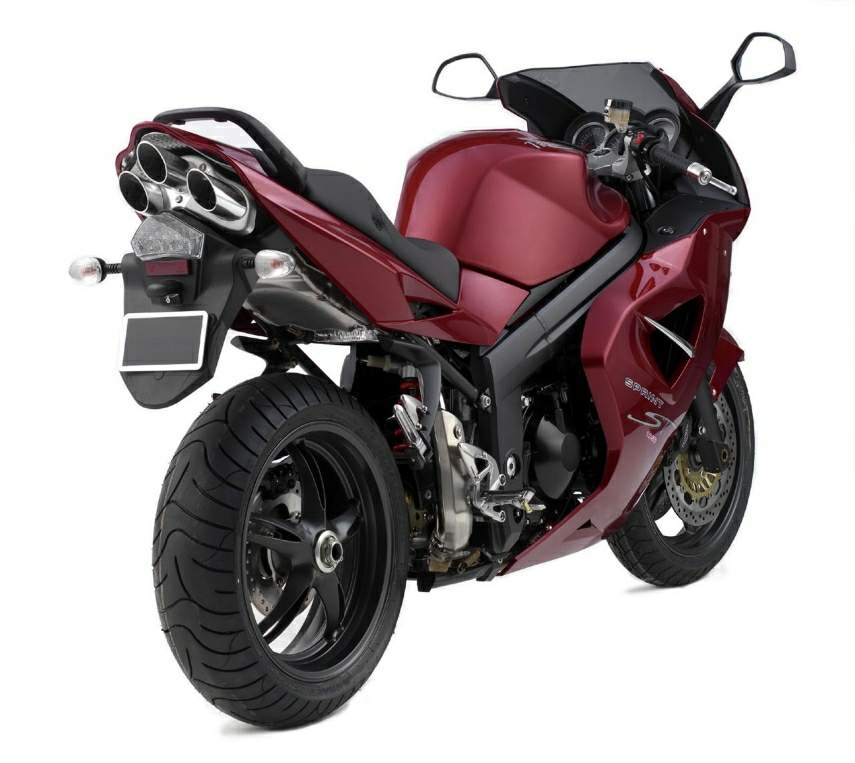
|
|
|
|
|
|
Classic Bikes
Custom Bikes
Individual
Racing Bikes AJP
AJS
Aprilia
Ariel
Avinton / Wakan
Bajaj
Benelli
Beta
Bimota
BMW
Brough Superior
BRP Cam-Am
BSA
Buell / EBR
Bultaco
Cagiva
Campagna
CCM
CF Moto
Combat Motors
Derbi
Deus
Ducati
Excelsior
GASGAS
Ghezzi Brian
Gilera
GIMA
Harley Davidson
Hero
Highland
Honda
Horex
Husaberg
Husqvarna
Hyosung
Indian
Jawa
Kawasaki
KTM
KYMCO
Laverda
Lazareth
Magni
Maico
Mash
Matchless
Mondial
Moto Guzzi
Moto Morini
MV Agusta
MZ / MuZ
NCR
Norton
NSU
Paton
Peugeot
Piaggio
Revival Cycles
Roland Sands
Royal Enfield
Sachs
Sherco
Sunbeam
Suzuki
SWM
SYM
Triumph
TVS
Ural
Velocette
Vespa
Victory
Vincent
VOR
Voxan
Vyrus
Walt Siegl
Walz
Wrenchmonkees
Wunderlich
XTR / Radical
Yamaha
Zero
Video
Technical
Complete Manufacturer List
|
Triumph Sprint ST 1050
Life is full of compromises, as are many motorcycles. The Sprint ST, thankfully, doesn't have to make any. It's a sports bike that covers miles, a touring bike that carves corners with a truly usable mix of poise, power and all-round practicality. And the Sprint ST has evolved even further. Its new 1050cc, fuel-injected, triple-cylinder motor has more of everything that makes it so usable - more torque, for effortless drive in any gear and more horsepower for when it's needed. Further refining the engine is a revised gearbox and clutch while the lusty nature of the three-cylinder layout, with its creamy delivery, remains unfettered. Matching the Sprint ST's engine is a new chassis with redesigned beam frame, cartridge-style telescopic forks and five-spoke wheels. Its sleek look is simply stunning and everywhere little touches, like the chrome infill bars and front indicators set in the mirrors, add class. Styling cues, such as the triple front headlights and triple exit exhausts, complement each other fluidly. The Sprint ST is a well-rounded platform for travel, adventure and excitment. Its success lies in its polish, the way it works as a complete machine, as a whole. Nope, compromise does not exist for the Sprint ST. It does it all in style, quite naturally. Triumph Urban Sports The word on the street is Triumph. And the sound that beats their arrival is a special and throaty roar. Sexy, head-turning looks are matched by exhilarating performance and precise handling. Road Test
Shooting through a corner past a 200-foot tall
Coastal Redwood, the candy apple red Triumph Sprint ST picked up easy as I aimed
it at the next twist of asphalt and dipped into yet another apex on California's
Redwood Highway, Â US-199.
Claimed horsepower on the three 1050s show that the
Sprint (125 hp, 77 lb-ft) has been tuned somewhere in the middle ground between
the high-octane Speed Triple streetfighter (131 hp, 77 lb-ft) and the less
prodigious but versatile Tiger adventure-tourer (114 hp, 74 lb-ft). When we
rolled the ST onto our rear-wheel dyno it topped out at 118.4 hp at 9400 rpm,
with torque numbers peaking at 72.1 lb-ft at 7800 rpm. Power production on the
Sprint is a nice blend of brute horsepower and usable torque. The flat torque
curve right there from bottom to top, while horsepower comes on strong and
steady with the upper revs really cranking it out.
Our only complaint with the Triple powerplant on the Sprint is the throttle
response, which wasn't altogether smooth.
A novelty at first, we'd gladly trade half of the
amusing-but-less-vital info, even instantaneous fuel consumption, for a gear
position indicator. Speaking of fuel consumption, during Lavine's 953-mile trek
the Sprint averaged 49.2 mpg, while our shorter, curvier coastal route saw 40.5
mpg figures.

|
|
|
Any corrections or more information on these motorcycles will be kindly appreciated. |